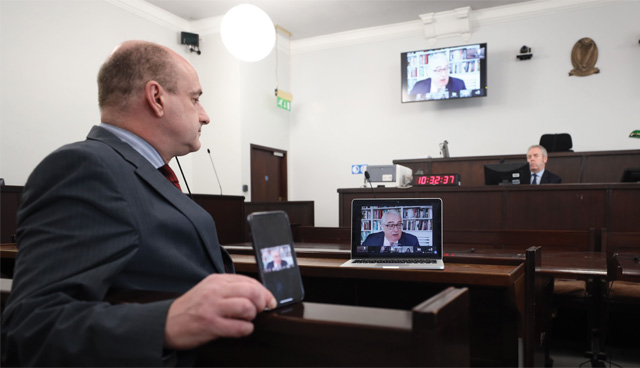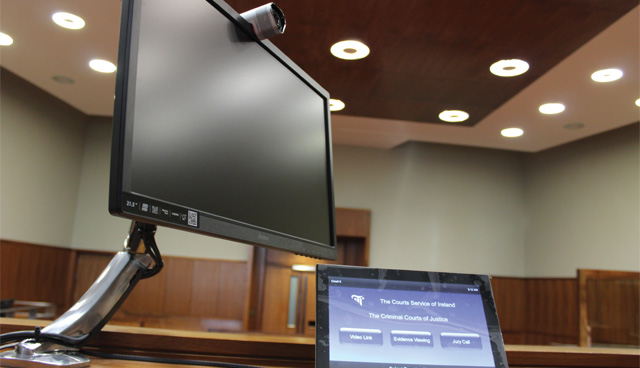A user-centric approach to digital transformation for the Courts

With 4,400 remote court sessions and over 16,350 video-link appearances in 12 months, it sounds as though the Courts Service is well on track to achieving its ambitious modernisation goals. However, they are only scratching the surface according to Angela Denning, CEO of the Courts Service. Denning explains how the Courts Service is placing the user at the centre of its modernisation plans to digitise court systems, processes and services, to achieve its long-term vision for a world-class justice system in Ireland.
The Courts Service is a statutorily independent state agency, providing frontline services to facilitate the administration and management of the Courts in Ireland. A large organisation, the Courts Service comprises 1,100 staff working across a nationwide network of offices and court venues, providing services in civil, criminal and family law to court users daily. The Courts Service facilitates approximately 445,000 criminal matters, 233,000 civil matters, and 20,150 domestic violence applications through the Superior, Circuit and District Courts annually. Paper intensive, the plan to digitise such extensive operations is no mean feat. However, Denning is unfazed: “We’re placing the user at the centre of our Modernisation Programme, which will realise our long-term strategic vision of a world-class justice system. Where digital solutions can improve the user experience, and allow us to deliver services that are easier, quicker and more cost efficient for all users, we will seek to implement them.”
The Courts Service was firmly in modernisation development mode when the pandemic hit, fortunately exploratory work in the area of remote courts had already commenced, enabling quick mobilisation of a remote court environment for suitable cases and matters. In their first year, remote courts have facilitated tens of thousands of matters across nearly all courts, with the Supreme Court and the Court of Appeal using them most prolifically. The result, reduced numbers attending court during the pandemic which supported the Courts Service Covid-19 safety management programme. Video-linked appearances with the Irish Prison Service have increased by 10,000 approximately in the past 12 months, helping to reduce prisoner movement and keep Covid out of the prisons.

Supporting the Courts Service’s ambitious plans and recognising how technology has helped to keep courts open and safe during the pandemic, the Government in Budget 2021 allocated over €2.2 million to upgrade courtroom technology. By the end of this year more than 100 courtrooms will have been tech enabled increasing the opportunities for evidence to be given remotely in suitable cases by witnesses including social workers, scientists from Forensic Science Ireland and members of An Garda Síochána. Although remote courts might be here to stay, having been cited by Sylvia Thompson in her Irish Times feature on 14 March 2021 as one of “16 sweet ideas to improve our country post-pandemic”, Denning remains user focused: “We now have much more informed users who have real-life experience of remote courts, we now need to listen to them and their feedback before we decide on solutions for the longer term, a project we’ve already started. Based on initial feedback, our experience to date and that of the judiciary, I would envisage a future of ‘hybrid courts’. A mix of physical and digital courts that would be suitable, to meet the varying needs of our diverse range of users.”
Denning continues by referencing Chief Justice Bridget McCormack of the Michigan Supreme Court who describes the modernising effect of the pandemic on their Courts as well in terms of “not being the disruption we wanted, but it might have been the disruption courts needed to accelerate change in a way that can produce a justice system that’s more accessible, transparent and efficient”.
The appetite for innovation demonstrated by Courts Service staff during the pandemic is key to how Denning envisages the Modernisation Programme building on the momentum created by the pandemic: “Through rising to the challenges of the pandemic together, we have learned many lessons and implemented new and creative solutions. The introduction of the iAuditor application is a good example of how our staff are open to digital innovation. Monitoring compliance levels with our Covid-19 safety management protocols on paper was going to be a real challenge across an expansive estate of court rooms and court offices nationwide. Colleagues identified a digital application which allows our network of Covid-19 worker representatives to upload compliance breaches in real-time so that they can be assessed immediately and addressed.”

In addition to robust Civil and Family Law and Organisational Reform Programmes, encouraging an innovative approach will support modernisation across the Courts Service. Denning explains: “This month sees the launch of our Innovation Strategy complete with innovation pathways, networkers and advocates who will champion sparks of creativity across the organisation to full business case proposals.”
At the building capability and capacity stage of its Modernisation Programme the Courts Service is introducing several strategies this year across the areas of communications, people and organisation development, estates and energy and ICT. The ICT Strategy will be key to the digital transformation of the Courts as it will set out how the Courts Service plans to develop its IT infrastructure and applications capability to support modernisation and the long-term vision.
The ICT Strategy will be followed by a data strategy setting out the Courts Service approach to leveraging the value of data to streamline operations, and to inform and improve timely and insightful decision making, while enshrining good data protection practices throughout the organisation. Both strategies will reflect the Government’s digital and data approach. Similar strategies are anticipated from other justice sector agencies who are also working to ambitious reform agendas. In full recognition of wider digital reforms planned across the justice sector and the fact that users tend to come into contact with one or more agencies as they journey across the justice system, the Courts Service is keen to collaborate with key partners across the sector. Denning explains: “Users come into contact with a number of different agencies as they experience the justice system, and they want to be able to transition smoothly from one interaction and one organisation to the next. As users become increasingly more digital savvy, they will expect a more efficient approach to data entry and will not expect to have to enter their data more than once to be in ‘the system’. We therefore need a joined-up approach across the justice sector without compromising the protection of people’s data rights whilst also ensuring maximum trust and transparency. The Courts Service is keen to continue to collaborate with our key partners to help users to navigate the wider digital reforms planned across the justice sector: to realise a digital vision for the future of the Courts which supports the user experience.”
For more information on the Courts Service visit www.courts.ie






